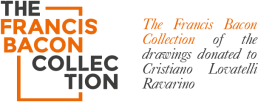MILIONART KALEIDOSCOPE 2.16
PROF. MAURIZIO SERACINI USES SCIENTIFIC TECHNIQUES TO AUTHENTICATE PAINTINGS, REVOLUTIONISING OUR UNDERSTANDING OF GREAT WORKS OF ART. SINCE 1977, WHEN HE FOUNDED EDITECH, THE FIRST PRIVATE COMPANY IN ITALY TO OFFER SCIENTIFIC SERVICES TO MUSEUMS AND TO THE ART MARKET, HE HAS STUDIED MORE THAN 4,000 WORKS OF ART. WE MET PROFESSOR MAURIZIO SERACINI IN HIS DIAGNOSTIC CENTRE FOR CULTURAL HERITAGE IN THE ELEGANT 17TH CENTURY PALAZZO TEMPI IN FLORENCE
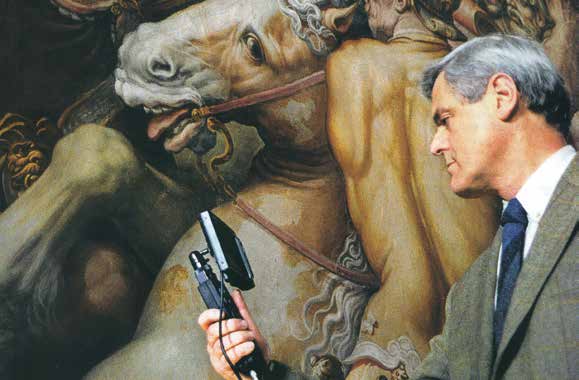
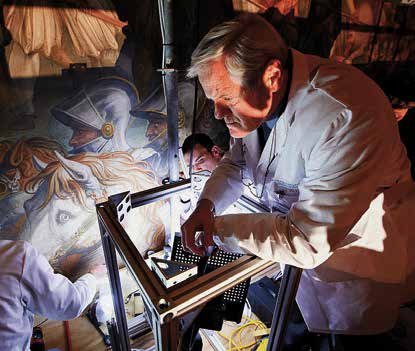
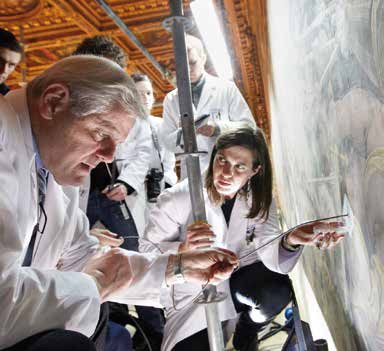
Maurizo Seracini – Anghiari‘s project
What conditions need to be in place to scientifically examine a work of art and deliver a professional evaluation to the client or institution?
The first step is to define a proper methodology, then to use state of the art technology together with a specific professional expertise for art authentication.
Science should provide objective data prior to any attribution or evaluation. What sense does it make to base a significantly financial art investment on an attribution which, it should be remembered is, in the best scenario, an educated opinion, if the authenticity of
the artefact has not been proved first by science? The buyers should be made aware of the risks they are running if they do not rely on objective data that only science can provide. Unfortunately, that awareness isn’t here yet and the art market doesn’t seem to encourage art investors to turn to science as a mandatory step prior an art purchase.
Do you agree that your scientific approach has been revolutionary?
It’s too soon to call it revolutionary. To do so, it should have an impact on how the conservation world and the art market is being run, but sadly, that still hasn’t occurred.
What does the art market think of scientists and art diagnosticians?
As I said, the art market runs basically on attributions. We all know that an attribution is a subjective opinion and is not legally binding. As everything revolves around opinions, in the art market there is plenty of room for speculation and all sort of illicit deals. That’s why the art market is not welcoming scientists to be engaged in this field.
Counterfeits have skyrocketed in the industry: how can investors safeguard their interests? Does a 100% fool proof evaluation exist?
It’s nothing new under the sun, as forgeries have been around for centuries, but today, given the skyrocketing value of works of art, making forgeries is becoming a very attractive and lucrative business compared to the past. In China, for example, producing fakes has become a real industry. A 100% fool proof evaluation would require the comparison of scientific data from a painting with a database from works of art that are considered absolutely authentic. The problem is creating many database, especially for modern and contemporary artists. Unfortunately, the art market, for the reasons mentioned before, has no real interest in making significantly big scientific database. Museums of old masters and of contemporary art alike, should be the first to generate their own database and make it public.
Which secrets, experience, and profound knowledge can you unveil when analysing important works of the old masters?
Studying a work of art of an old master is a wonderful and very challenging experience. You are trying to unveil the genesis of a masterpiece, to understand how the artist with just a piece of canvas or wood and some colours was able to express his creativity, his genius.Science can show a step-by-step guide of how this masterpiece was generated and how the artist was able to achieve such peaks of style and beauty. Let’s take the example of Raphael’s ‘Lady with a Unicorn’ in Rome’s Galleria Borghese: we revealed that there was no unicorn in the original version of the painting, though a dog and other features were added by a second artist. The unicorn was painted on top of the dog in a later phase, and then concealed in the 17th century when the painting was transformed into a portrait of St Catherine. It was only in 1935 that the unicorn reappeared when the painting was restored. This is just one example of what science can do in order to make us rediscover the value of our culture. Science is not competing with art historians. Instead, it provides new knowledge about the iconography, iconology, style, painting technique of a work of art not otherwise obtainable.
Can you give us an example of one of your projects which shook the art world?
In a six-month study of Leonardo’s ‘Adoration of the Magi’ in the Uffizi Gallery we uncovered an incredible underdrawing never seen for more than five centuries, which showed over 70 figures, a fierce battle scene and even an elephant. Leonardo left his masterpiece unfinished and it was later covered with a brownish colour by another artist. When 15 years ago I showed that the monochrome painting was not the work of Leonardo, but rather a later and ugly repaint, the community of art historians raised in arms and I was heavily criticized. Now, the Adoration is going through an extensive cleaning which is removing most of the monochrome paint layer that was so fiercely believed to be authentic. Science proved to be right, after all!
How important is the revelation of Leonardo da Vinci’s allegedly lost masterpiece ‘The Battle of Anghiari‘?
I never announced that I found ‘The Battle of Anghiari’. Very small fragments of coloured materials on a plastered wall behind the Vasari wall were found. Granted that it was not enough to associate those fragments to ‘The Battle of Anghiari’, but why was I not allowed to continue the investigation?
Why was I forced to shut down the whole operation? All the financing came from an English sponsor by the name of Lord Guinness. It was proved beyond any doubt that no damage was done to Vasari’s mural. So, once again, why such animosity, such antagonism against the search? Trying to unveil the mystery on the most acclaimed masterpiece of Leonardo, called the school of the world by his contemporaries, was considered an outrage to Leonardo’s scholars and not only? Luckily, science main drive has always been the curiosity and the thirst for new knowledge, otherwise we would still be in the Stone Age. Unveiling ‘The Battle of Anghiari’ to the world would be not just the greatest discovery in art history but it would reveal to all of us the highest form of art ever achieved by an artist at the peak of the Renaissance. We should remember that when Leonardo was working on ‘The Battle of Anghiari’, was also painting the Mona Lisa, today the world icon and the main attraction at the Louvre. No document has ever been found praising this painting, most likely because the Mona Lisa was just a portrait like any other in Leonardo’s workshop to make ends meet. So, imagine what impact the discovery of ‘The Battle of Anghiari’ would have worldwide.
You’ve raised the bar with your work. What is your vision and the main goal you want to reach in the next years?
I would be very glad if the professional figure of the conservation scientist would be part of the staff in every museum and he would be allowed to be in charge of all the conservation issues, in addition to be part of the decision making process to restore a work of art. I would also like to see the art market to introduce as mandatory scientific exams to prove authenticity before a work of art is put for sale. Personally, I would like to have the honour to study other works of Leonardo, since so few have been examined scientifically. But above all, my vision which I hope more and more people would like to embrace, would be to give a “future to our past”. Science could be instrumental to reach this goal worldwide
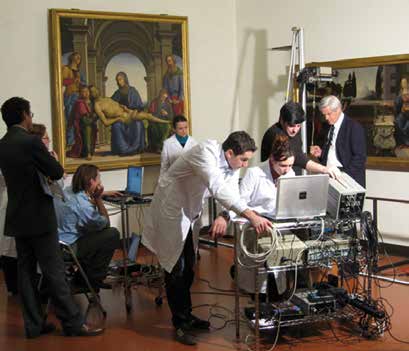
Caravaggio‘s paintings scientific analysis
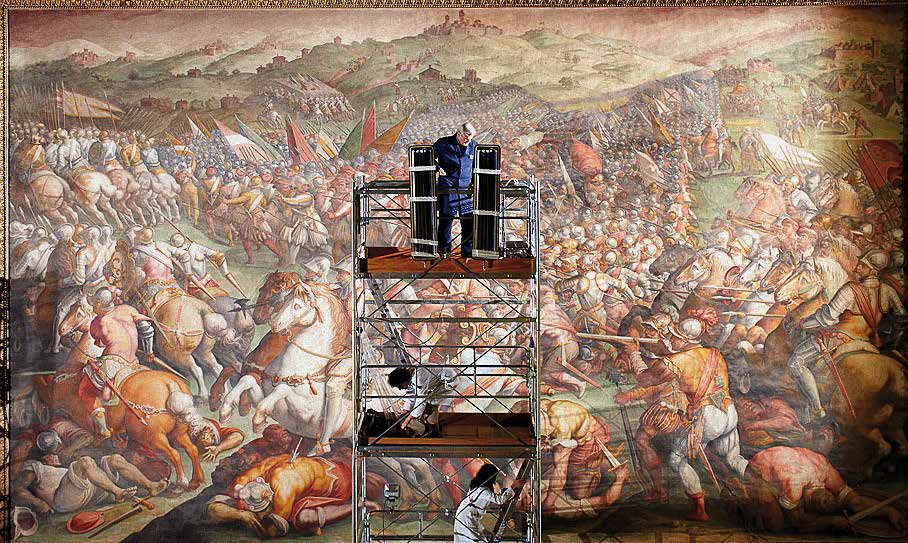
Hall of the 500
